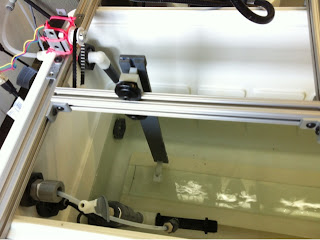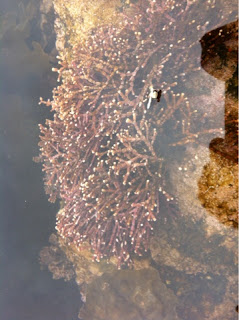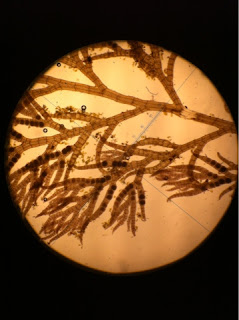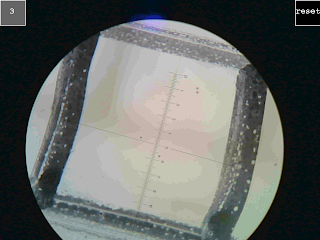Hey everyone! So, it's been an eventful 8 weeks, but an extremely productive one. Thanks for supporting me on this research expedition! I will be leaving the island this coming Monday, to resume my day job as a curriculum designer for Iridescent. This blog will turn into my personal blog and homepage, so I encourage you to stay tuned if you're interested in hearing more about science, education, online learning, and games.
To wrap up- first, if you donated at least $100 and would like a particular algae pressing sent to you, now's the time to say so! I will be sending out the pressings this weekend, so please make your choice by Friday at midnight, otherwise I will select one at random for you.
A quick summary of the results of this summer:
I built a shear flume. Yay! It's super sweet and somewhat surprisingly works the way I intended.
I got a little bit of data showing that the spores of one of the local species are as fast and as strong as the species in my thesis. Thus the pattern seems general- red algal spores can produce an glue which can set, underwater, in a matter of minutes and is extremely strong once set. We as humans have yet to manufacture a glue which acts nearly as good as this.
I also found that pH has a negative effect on algal spores- it seems to make them take longer to attach to surface, maybe making it more difficult for them to settle and become adults.
The research doesn't end here! Becca Guenther, a PhD student at the University of British Columbia, has been following me around for the last few weeks, learning the ins and outs of the flume. This research (in particular on ocean acidification) will continue as part of her PhD research. I was really excited to hear her tell me this! It means all the work I put into this summer will continue to develop into more and more interesting science, as the flume becomes a staple piece of equipment in the lab here at FHL.
I just wanted to end by saying thanks! to everyone who donated money and helped support my research. I hope the blog was enjoyable, feel free to drop me a line or leave a comment if there's anything you want to hear more about or see. Thanks again for supporting science!!
Kevin
Friday, July 27, 2012
Tuesday, July 24, 2012
Week 8: Graphs
Ok! At this point, I've collected data on the attachment of almost 600 spores. That's what nonstop data collection for 2 weeks straight gets you. That's a lot of data points! I finally got to plotting this data to share here. This data is super-fresh, like 2 hours since I generated it.
The main species I've been using is Pterosiphonia bipinnata, (which I initially misidentified as a Polysiphonia). Here's what it looks like under a microscope:
The main species I've been using is Pterosiphonia bipinnata, (which I initially misidentified as a Polysiphonia). Here's what it looks like under a microscope:
It has these cute little tiers of cells that give it a banding pattern.
The spores are made on the inside of the tube of cells, kind of like a
jelly-filled long-john donut. You can see the packet of spores as lines of darkly colored dots. These packets break into 4 individual spores once released.
Ok, and now to the main story of spore attachment. I'm plotting the shear stress (or how strongly spores have attached) on the x-axis, with the time that the spores had been settling on the y-axis. Since what I see is spores that are around at one shear and then gone at the next, I know that the attachment strength of the spores lies in between the forces of when I last saw it to when it was gone. So I decided to plot the data as a bar, showing the range of where the spore's attachment strength must be, for how long they have settled.
This data is actually really cool! It confirms the work of my thesis that spores attach really quickly and strongly. How do I know this? Well, notice that most of the points group on the left side of the graph, at really low attachment strengths where they are barely attached, or on the right side of the graph, where spores are really strongly attached. I rarely catch spores at intermediate attachment strengths, meaning spores really just have one of two states: 1) unattached and waiting for a wave to knock them to a better location, and 2) fully attached, unable to be shaken by the strongest waves. For Pterosiphonia bipinnata (as well as the species in my thesis), it may take several hours for them to "decide" to switch from state 1) to 2), but when they decide to do it, the switch happens faster than we can usually catch in our shear flume (on the order of minutes).
Oddly enough, Pterosiphonia bipinnata takes quite a while to make the decision to attach. It is rarely attached in anything less than 12 hours, and even after 24 hours most but not all spores have moved to the right side of the graph (indicated by the darker color of the lines at 24 hours).
At some point, I had accidentally tested a different species, and hadn't noticed till afterwards, when I had an outlier where spores were fully attached in 10 hours in just a few tests. Going back to them, I found I actually had tested Polysiphonia hendryi. Here's the few data I collected for it:
And last, I ran a few pH tests. So the big question: how will Pterosiphonia's spores fare in a future, acidic ocean? The answer: not well. In 24 hours of attachment, 73% of the spores had attached in the normal waters, but only 35% managed to attach in the acidic water. It's interesting that as far as I could tell, when the spores did attach, they were just as strong, but seem to be taking longer to make that decision to attach. I don't have enough trials yet to be fully confident in this story (I still got a few more days here!), but the trend so far is quite strong and I hope it'll hold up to more data.
Wednesday, July 18, 2012
Week 7: more data
Hey,
Quick update this week, as I'm busy plugging along for more data, now that everything seems to be working dandy (minus a power outage that happened this weekend, and set everything back a day). Trying to analyze the data as I go, but haven't quit caught up yet. Hoping to psot some results here by the end of the week.
Also, put a few more pressings up on the page, from the big stuff I collected from the FHL dock. A few didn't come out so well, but there's still several good ones, if you are looking for the big and busty designer algae. There'll be another 3-4 pressings added to the list by the end of the week, and then I'll ship them out the week after. Claim your algae soon!
Quick update this week, as I'm busy plugging along for more data, now that everything seems to be working dandy (minus a power outage that happened this weekend, and set everything back a day). Trying to analyze the data as I go, but haven't quit caught up yet. Hoping to psot some results here by the end of the week.
Also, put a few more pressings up on the page, from the big stuff I collected from the FHL dock. A few didn't come out so well, but there's still several good ones, if you are looking for the big and busty designer algae. There'll be another 3-4 pressings added to the list by the end of the week, and then I'll ship them out the week after. Claim your algae soon!
Friday, July 13, 2012
Week 6: DATA!!!
The last few days were a glorious ride. After struggling with many different species, I finally got on of the local fuzzy red species, Polysiphonia sp. (I'll key it out later), to release spores! And then I saw the spores with a microscope, blasted them with my flume, and collected some super sweet images. The moment of first data is always a momentous occasion in any research project. At the moment I realized that the last five weeks of effort were going to finally work, I literally screamed "Yes, data!!!" at the top of my lungs. Becca, who was helping me set this up at the time, looked over at me with an expression that was a mix of "Oh my god this guy is crazy," and "Yeah, I totally understand that feeling."
I found the only way to truly get really good images with the microscope was to eliminate any sort of air/water interface (discovered accidentally, as my microscope casing broken and filled with water). So I needed to dunk the lens in the water. I sealed the top of the lens so no water would get in the microscope barrel itself, then dunked the lens in water, and behold!: beautiful spores. This was Moose's suggestion, and will probably ruin the lens at some point, but for now it's working splendidly. But replacing a lens every so often isn't the worst operating expense.
Here's a with and without a barrier image, of the same set of spores:

And then, a sequence of image showing the number of spores remaining on the slide after hitting the spores with greater and greater force. The first picture has 4 spores, which got knocked down to 3 and then 1. Can you find them?
And last, the data graphic that resulted from this first set. I had eight spores in view on this test, so I marked the information pertaining to the spores when they were de-attached. So when the spore became deattached, how long had it been settling, and what force was needed to deattach it. The points on the farthest right actually never became deattached. The darker points are actually two overlapping data points.
And as a final bit of news, I'll be posting some more algae pressings that are almost dry in the next few days. I got some really big ones in this set from the dock at FHL, after these I'll make one more set of smaller, more delicate (and in my opinion) more beautiful algae.
I found the only way to truly get really good images with the microscope was to eliminate any sort of air/water interface (discovered accidentally, as my microscope casing broken and filled with water). So I needed to dunk the lens in the water. I sealed the top of the lens so no water would get in the microscope barrel itself, then dunked the lens in water, and behold!: beautiful spores. This was Moose's suggestion, and will probably ruin the lens at some point, but for now it's working splendidly. But replacing a lens every so often isn't the worst operating expense.
Here's a with and without a barrier image, of the same set of spores:

And then, a sequence of image showing the number of spores remaining on the slide after hitting the spores with greater and greater force. The first picture has 4 spores, which got knocked down to 3 and then 1. Can you find them?
And last, the data graphic that resulted from this first set. I had eight spores in view on this test, so I marked the information pertaining to the spores when they were de-attached. So when the spore became deattached, how long had it been settling, and what force was needed to deattach it. The points on the farthest right actually never became deattached. The darker points are actually two overlapping data points.
And as a final bit of news, I'll be posting some more algae pressings that are almost dry in the next few days. I got some really big ones in this set from the dock at FHL, after these I'll make one more set of smaller, more delicate (and in my opinion) more beautiful algae.
Tuesday, July 10, 2012
Week 6: Too stressed to spawn, and pressing highlight
Well, after recovering from a less-than-productive holiday week, I've returned to find my project still beset with problems. There are only two problems now getting between me and data.
1) Seeing spores with my microscope. This problem is mostly solved, I've now totally revamped my microscope setup, allowing for more maneuverability and clarity (a fancy way of saying I wrapped the microscope in a plastic bag and secured it with a rubber band). This hack job setup actually solved a whole bunch of problems- easier to light, more stable attachment, easier to maneuver, and better clarity. And for a brief moment, I actually saw spores! Three lonely spores, from one proud Calliarthron tuberculosum mother.
The setup is still a little unstable, and the vibrations in the carriage might actually cause blurry pictures when I use it to move the camera back and forth. This problem is fixable though, either by 1) manually moving the webcam to set positions, 2) making a new carriage or 3) or if all else fails, counting the spores by eye, without the webcam. I will figure out which solution to use when I have spores to look at, which leads to the next problem.
2) No spores. I've now confirmed that the algae I've been working with have just not been releasing spores, or releasing in such low numbers as to be useless.
I've been mostly working on Corallina vancouveriensis, the same species I worked on in Monterey and had good success with. After several sets of no spore release, I finally took them under a microscope and dissected their reproductive structures yesterday. And, well, they didn't look so hot. Compared to Monterey, they had lower numbers of of reproductive structures, lower numbers of spores in their structures, and the ones that did have spores had pretty crappy, deformed spores. So, no wonder I wasn't getting good release.
I talked things over with Becca, and we formulated several strategies:
1) Collect Corallina in a new location on the island, where it might be healthier.
2) Get some divers to collect Calliarthron tuberculosum, my other study species. This species also doesn't look too sexy in the intertidal, but Becca said she's found healthier and more reproductive fronds from subtidal locations.
3) Put intertidal Calliarthron in a dark growth chamber, where a colleague of hers said she got that species to form reproductive structures.
4) Switch to an entirely different coralline or noncoralline species, chosen based on local health and reproductive state.
We're actually going to pursue all these strategies simultaneously for the rest of the week, hoping at least one of them pans out and solves this problem.
Pressing Highlight: Microcladia borealis
This highlight features a relative to one of our previous favorites, Microcladia coulteri. The second and only other representative from this genus in the area, Microcladia borealis looks a fair bit different from its cousin. It's less flattened and has more tube-like branches that often become entangled with one another, causing it to look like a hairy mess in the field. But pull it apart for a pressing, and it's simply gorgeous.
The species has what's called a unilateral branching pattern. That simply means when branches form off a trunk, they always form on the same side. Those branches can form sub-branches, but the sub-branches will again pick a side and only form on that side. You can see this unique pattern in the pressing. This gives a unique design and shape to the algae. I always thought this algae would make a great suit in a deck of cards, like a club or spade, or frond (hehe).
This algae is generally pretty small, with branches extending usually no more than a few inches from the main branch. But because of it's delicate size, it takes extreme care and effort to turn it into a pressing. I spent more time arranging pressings for this species than I do for any other.
1) Seeing spores with my microscope. This problem is mostly solved, I've now totally revamped my microscope setup, allowing for more maneuverability and clarity (a fancy way of saying I wrapped the microscope in a plastic bag and secured it with a rubber band). This hack job setup actually solved a whole bunch of problems- easier to light, more stable attachment, easier to maneuver, and better clarity. And for a brief moment, I actually saw spores! Three lonely spores, from one proud Calliarthron tuberculosum mother.
The setup is still a little unstable, and the vibrations in the carriage might actually cause blurry pictures when I use it to move the camera back and forth. This problem is fixable though, either by 1) manually moving the webcam to set positions, 2) making a new carriage or 3) or if all else fails, counting the spores by eye, without the webcam. I will figure out which solution to use when I have spores to look at, which leads to the next problem.
2) No spores. I've now confirmed that the algae I've been working with have just not been releasing spores, or releasing in such low numbers as to be useless.
I've been mostly working on Corallina vancouveriensis, the same species I worked on in Monterey and had good success with. After several sets of no spore release, I finally took them under a microscope and dissected their reproductive structures yesterday. And, well, they didn't look so hot. Compared to Monterey, they had lower numbers of of reproductive structures, lower numbers of spores in their structures, and the ones that did have spores had pretty crappy, deformed spores. So, no wonder I wasn't getting good release.
I talked things over with Becca, and we formulated several strategies:
1) Collect Corallina in a new location on the island, where it might be healthier.
2) Get some divers to collect Calliarthron tuberculosum, my other study species. This species also doesn't look too sexy in the intertidal, but Becca said she's found healthier and more reproductive fronds from subtidal locations.
3) Put intertidal Calliarthron in a dark growth chamber, where a colleague of hers said she got that species to form reproductive structures.
4) Switch to an entirely different coralline or noncoralline species, chosen based on local health and reproductive state.
We're actually going to pursue all these strategies simultaneously for the rest of the week, hoping at least one of them pans out and solves this problem.
Pressing Highlight: Microcladia borealis
This highlight features a relative to one of our previous favorites, Microcladia coulteri. The second and only other representative from this genus in the area, Microcladia borealis looks a fair bit different from its cousin. It's less flattened and has more tube-like branches that often become entangled with one another, causing it to look like a hairy mess in the field. But pull it apart for a pressing, and it's simply gorgeous.
The species has what's called a unilateral branching pattern. That simply means when branches form off a trunk, they always form on the same side. Those branches can form sub-branches, but the sub-branches will again pick a side and only form on that side. You can see this unique pattern in the pressing. This gives a unique design and shape to the algae. I always thought this algae would make a great suit in a deck of cards, like a club or spade, or frond (hehe).
This algae is generally pretty small, with branches extending usually no more than a few inches from the main branch. But because of it's delicate size, it takes extreme care and effort to turn it into a pressing. I spent more time arranging pressings for this species than I do for any other.
Tuesday, July 3, 2012
Week 5: if only I could see...
Vision issues. Everything is basically complete, except... I haven't seen spores yet. And this continues to be a problem.
A few test runs this week got algae to release spores in my tanks, but that I simply wasn't seeing them. After scourging the microscope and webcam optics all day yesterday, I finally found the culprit: bubbles, and maybe low light levels. Because the my tanks are constantly bubbled with CO2 enriched air to keep the acidity constant, there are just too many air bubbles floating around. In almost not time flat, they cover the glass plate under my microscope and just make it impossible to clearly see anything
I think this is a solvable problem, I'm just figuring out how. I improvised a plastic bag to contain the microscope today, and it seemed to work pretty well. Further tests with spore release will tell. It's really annoying to be so close to my first really data, and to have bubbles get in the way.
In any case, went on another beautiful collecting trip. I got some great pictures of the three species I'll be working on this summer: the two pink corallines from my PhD, and a third fleshy (not calcified) red algae that I've had good success in the past getting spore release from.
In any case, happy 4th of July everyone!
A few test runs this week got algae to release spores in my tanks, but that I simply wasn't seeing them. After scourging the microscope and webcam optics all day yesterday, I finally found the culprit: bubbles, and maybe low light levels. Because the my tanks are constantly bubbled with CO2 enriched air to keep the acidity constant, there are just too many air bubbles floating around. In almost not time flat, they cover the glass plate under my microscope and just make it impossible to clearly see anything
 |
| A picture of the setup, in total. |
I think this is a solvable problem, I'm just figuring out how. I improvised a plastic bag to contain the microscope today, and it seemed to work pretty well. Further tests with spore release will tell. It's really annoying to be so close to my first really data, and to have bubbles get in the way.
In any case, went on another beautiful collecting trip. I got some great pictures of the three species I'll be working on this summer: the two pink corallines from my PhD, and a third fleshy (not calcified) red algae that I've had good success in the past getting spore release from.
 |
| Corallina vancouveriensis, the one that look like rose petals |
 |
| Calliarthron tuberculosum, spiny and spickly. |
 | ||||
| Polysiphonia sp. Really common, mat-like algae. Pull it apart and its a bunch of fine, interwoven branches. |
Subscribe to:
Posts (Atom)











